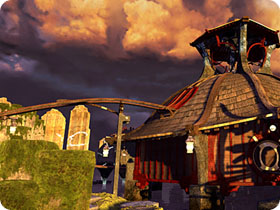|
Page 1 | 2 |

|
Presto’s opportunity to create Myst III involved one part fate and one part luck. The Miller brothers’ company, Cyan, had dedicated its resources to a top secret project and didn’t plan to make another Myst game. The Learning Company (which later, after a series of buy-outs involving other companies, became part of Ubi Soft) approached Cyan with a proposal to create a third game in the series and, after receiving approval, asked Presto to do the development.

DeMarle, who consulted the first two games, the three Myst novels, and the two Myst comic books as part of her research, recalls the first meeting with Cyan after the contracts were signed.
“Rand Miller and Tony Fryman were there,” she says, “and I remember Rand saying that the D’ni universe was ‘wide open’ to us. In fact, he said that he was looking forward to playing a Myst game in which he didn’t know every single puzzle solution by heart.”
Cyan had final say over the story, and the company’s D’ni historian, Richard Watson, consulted with DeMarle whenever she wanted to make sure that she wasn’t contradicting what had already been established about the Myst universe.
“They provided us with a tapestry on which to paint a masterpiece,” Irish says of Cyan. “As long as we stayed on that canvas we were fine, and they gave us total control and freedom.”

The Amateria Age.
Meaningful Choices
Like Myst and Riven, the puzzles in Myst III get progressively more difficult as you make your way deeper into the game. Each age has a distinct theme that ties into the type of puzzles you will encounter: Tomahna, Atrus and Catherine’s new home, is full of gardens; J’nanin is an island of menacing granite cliffs and mysterious formations; Voltaic is dry and dusty; Amateria, a land in the middle of a black sea, is full of Atrus’ inventions; and Edanna overflows with exotic plants and animals.
For example, the puzzles in Edanna are all organic and require taking and giving life to solve them.
Creative director Phil Saunders’ mantra regarding game development is that a game is “a series of meaningful choices in order to reach a clear goal,” a phrase that everyone at Presto, especially producer Greg Uhler, took to heart as they created the puzzles.
“We evaluated individual puzzle ideas as well as a series of puzzles according to that mantra,” he says. “If a puzzle fit well, we knew it would translate into a good experience for the player.”

The Edanna Age.
M is For Myst
If you’re concerned that you have to play the first two games before tackling this one, though, don’t worry: Presto made sure that anyone with no prior knowledge of Myst could pick up Exile and play it. Die-hard fans will appreciate the little touches, but this game truly is intended for anyone.
“Exile’s plot is like that of any good mystery novel,” explains DeMarle. “At first, you don’t know anything. But the more you investigate, the more you uncover pieces of the puzzle. In Exile, those pieces include all the historical information about Myst, Riven and the D’ni universe that you need to know in order to understand and eventually solve the conflict.
“So knowing nothing about the earlier games is not a problem. By the end of Exile, you’ll know enough.”
Mac OS X Ready
A patch is available for download that makes Myst III Mac OS X compatible.
|
Rand and Robyn Miller released the original Myst through Broderbund Software in 1993. The game was the result of their desire to do something more complex than the children’s titles (The Manhole, Cosmic Osmo and Spelunx) that they had created in the past with the small staff at their development company, Cyan. That year also saw the release of the first issue in Dark Horse Comics’ proposed four-issue mini-series Myst: The Book of the Black Ships, which was to focus on Atrus and his sons Sirrus and Achenar. Unfortunately, according to Richard Watson, Cyan’s D’ni Historian, “the rest of the series was cancelled by us because the first issue did not match our expectations.” “Another Myst comic, Myst #0: Passages, was later published, but was only available online. The story featured Atrus and his father, Gehn.” In 1995, Hyperion published the Miller brothers’ Myst: The Book of Atrus, the first of three novels that delve into Atrus’ past. That book was followed by 1996’s Myst: The Book of Ti’ana and 1997’s Myst: The Book of D’ni. Meanwhile, the original Myst was due for a facelift, which happened in 2000 with the release of Myst: Masterpiece Edition. This version features enhanced sound and graphics as well as a “Digital Guide” help system that can guide you through the game’s ages if you’d like. In late 2000, Broderbund released realMyst for the PC, which was the first Myst game that allowed the player to freely move through the 3D environment, instead of looking at it through the so-called snapshot view. MacPlay expects to release the Macintosh version in March 2002. According to Chris Brandkamp, Cyan’s Vice President of Business Affairs, the series will not go away after the release of Myst III: Exile. The company’s top secret project, known currently only as “Mudpie,” will be an online persistent world multiplayer game for broadband that takes place in the D’ni Universe. |

* Via the Mac OS X Myst III patch. |
Download Mac OS X Patch
For more pictures from Myst III: Exile, visit the official site.